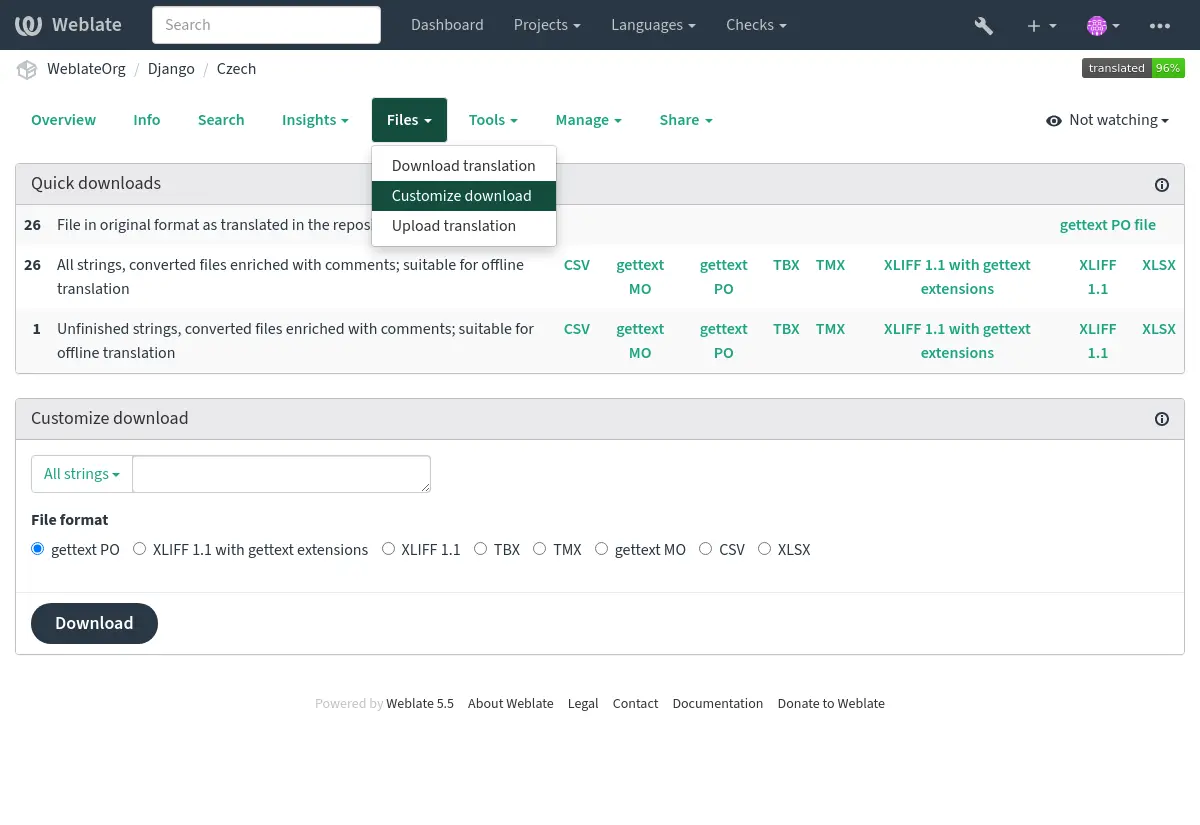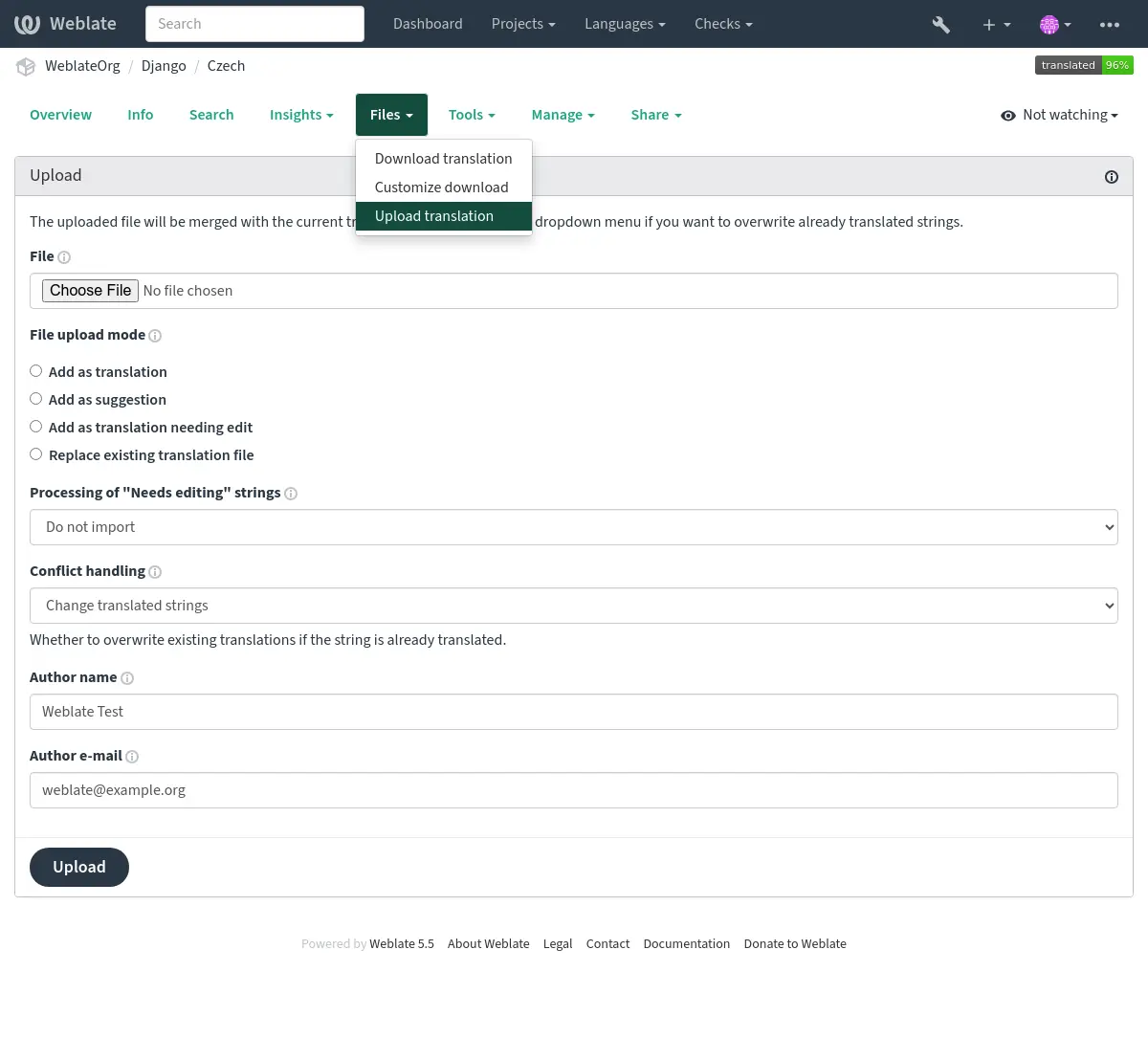Shkarkim dhe ngarkim përkthimesh¶
You can export files from a translation, make changes, and import them again. This allows working offline, and then merging changes back into the existing translation. This works even if it has been changed in the meantime.
Shënim
Available options might be limited by access control settings.
Shkarkim përkthimesh¶
From the project or component dashboard, translatable files can be downloaded in the Files menu.
The first option is to download the file in the original format as it is stored in the repository. In this case, any pending changes in the translation are getting committed and the up-to-date file is yield without any conversions.
You can also download the translation converted into one of the widely used localization formats. The converted files will be enriched with data provided in Weblate; such as additional context, comments or flags. Several file formats are available via the Files ↓ Customize download menu:
gettext PO (
po)XLIFF 1.1 with gettext extensions (
xliff)XLIFF 1.1 (
xliff11)TermBase eXchange (
tbx)Translation Memory eXchange (
tmx)gettext MO (only available when translation is using gettext PO) (
mo)CSV (
csv)Excel Open XML (
xlsx)JSON (only available for monolingual translations) (
json)JSON nested structure file (only available for monolingual translations) (
json-nested)Android String Resource (only available for monolingual translations) (
aresource)iOS strings (only available for monolingual translations) (
strings)
Ndihmëz
The content available in the converted files differs based on file format features, you can find overview in Translation types capabilities.

Downloading components, categories or projects¶
Translation files for a component, category or project can be downloaded at once via the Files menu. The download is always served as a ZIP file, and you can choose original or converted formats similarly as in Shkarkim përkthimesh.
Ngarkim përkthimesh¶
When you have made your changes, use Upload translation in the Files menu.

Formate të mbuluar kartelash¶
Any file in a supported file format can be uploaded, but it is still recommended to use the same file format as the one used for translation, otherwise some features might not be translated properly.
Import methods¶
These are the choices presented when uploading translation files:
- Shtoje si përkthim (
translate) Imported strings are added as translations to existing strings. This is the most common usecase, and the default behavior.
Only translations are used from the uploaded file and no additional content.
This option is available only if the user has the «Edit strings» permission.
- Shtoje si sugjerim (
suggest) Imported strings are added as suggestions. Do this when you want to have your uploaded strings reviewed.
Only translations are used from the uploaded file and no additional content.
This option is available only if the user has the «Add suggestion» permission.
- Add as approved translation (
approve) Imported strings are added as approved translations. Do this when you already reviewed your translations before uploading them.
Only translations are used from the uploaded file and no additional content.
This option is available only if the user has the «Review strings» permission.
- Shtoje si përkthim që lyp përpunim (
fuzzy) Imported strings are added as translations needing edit. This can be useful when you want translations to be used, but also reviewed.
Only translations are used from the uploaded file and no additional content.
This option is available only if the user has the «Edit strings» permission.
- Zëvendëso kartelë ekzistuese përkthimi (
replace) Existing file is replaced with new content. This can lead to loss of existing translations, use with caution.
This option is available only if the user has the «Edit component settings» permission or «Add new string», «Remove a string» and «Edit strings» permissions.
- Përditëso vargje burim (
source) Updates source strings in bilingual translation file. This is similar to what Përditësoni kartela PO, që të përputhen me POT (msgmerge) does.
This option is available only for some file formats and only if the user has the «Upload translations» permission.
- Add new strings (
add) Adds new strings to the translation. It skips the one which already exist.
In case you want to both add new strings and update existing translations, upload the file second time with Add as translation.
Only source, translation and key (context) are used from the uploaded file.
This option is available only with Administroni vargje turned on and only if the user has the «Add new string» permission.
Trajtim përplasje¶
Defines how to deal with uploaded strings which are already translated:
- Change only untranslated strings (
ignore) Ignore uploaded translations which are already translated.
- Change translated strings (
replace-translated) Replace existing translations with uploaded ones, but keep approved ones.
- Change translated and approved strings (
replace-approved) Replace existing translations with uploaded ones, including approved ones.
Vargje që lypin përpunim¶
There is also an option for how to handle strings needing edit in the imported file. Such strings can be handle in one of the three following ways: «Do not import», «Import as string needing edit», or «Import as translated».